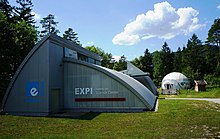Expi- hands on Science Center
The Expi is a permanent exhibition of interactive exhibits from different areas of the natural sciences. The opening took place on July 2, 2010. The Expi is located in Gotschuchen , municipality of Sankt Margareten im Rosental in the south of Carinthia , about 20 km south of Klagenfurt near the border with Slovenia and is the first science center in Carinthia.
Content
On approx. 400 m² of covered exhibition space, visitors are introduced to natural science topics in a playful way at around 50 experiment stations based on the concept of a science center. In addition to the permanent exhibition, traveling exhibitions on physical topics are presented at changing intervals. Instead of "touching prohibited", the EXPI applies "trying it out". In 2020 "The World of Particles" - an interactive hands-on exhibition about atoms, nuclei and elementary particles will be presented. This is how visitors get answers to questions:
- What does radioactivity look like?
- How much of it is actually around us?
- Are there also cosmic rays on earth?
- How can you see heat in the EXPI?
- How fast can protons become in the large particle accelerator LHC?
- What is the Higgs particle?
Worth seeing for visitors:
- the walk-in "kaleidoscope"
- the invisibility table
- the writing pendulum
- a rotating mirror
- the big-small room or
- the fog tornado you can touch.
Exhibits
The best-known exhibit is the four-meter-high three-dimensional representation of a tribar , an " impossible figure " in the shape of a triangle with three right angles .
The larger exhibits include a walk-in Ames room , a pentagonal kaleidoscope that is also walk-in, and a 2.5-meter-high tornado that is created at the push of a button and can also be touched by visitors. In addition to classics such as the Newton pendulum , historical experiments such as a Foucault pendulum , the Magdeburg hemispheres or the presentation of the first color photo by JC Maxwell are shown and explained with the help of interactive exhibits. Most of the exhibits were developed and built by members of the Science Center and the local association Treffpunkt Physik.
A group of exhibits are dedicated to the subject of particle physics , which is playfully prepared for different ages: An interactive model of the Large Hadron Collider over the speed of light , developed by the HEPHY of the Austrian Academy of Sciences , a spark chamber for the detection of cosmic radiation, since 2014 a large diffusion cloud chamber for Visualization of radioactive rays, an exhibit for the detection of natural radioactivity with a vacuum cleaner, a station for thermal radiation with an infrared camera and an experiment station for the polarization of light rays allow visitors, regardless of previous knowledge, easy and interesting access to demanding areas of physics.
Web links
Individual evidence
Coordinates: 46 ° 32 ′ 41.3 " N , 14 ° 23 ′ 24.2" E

